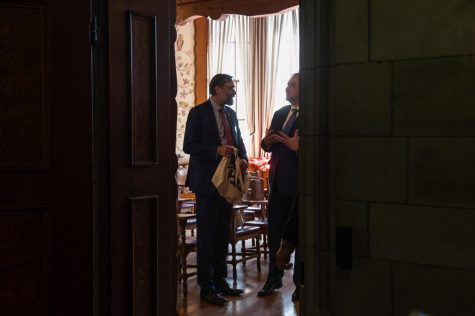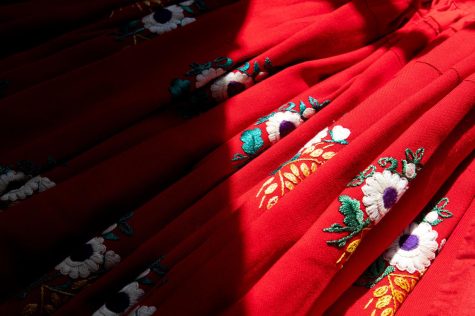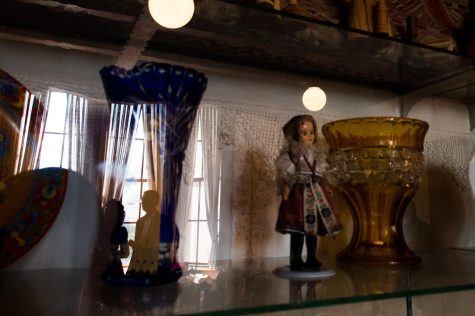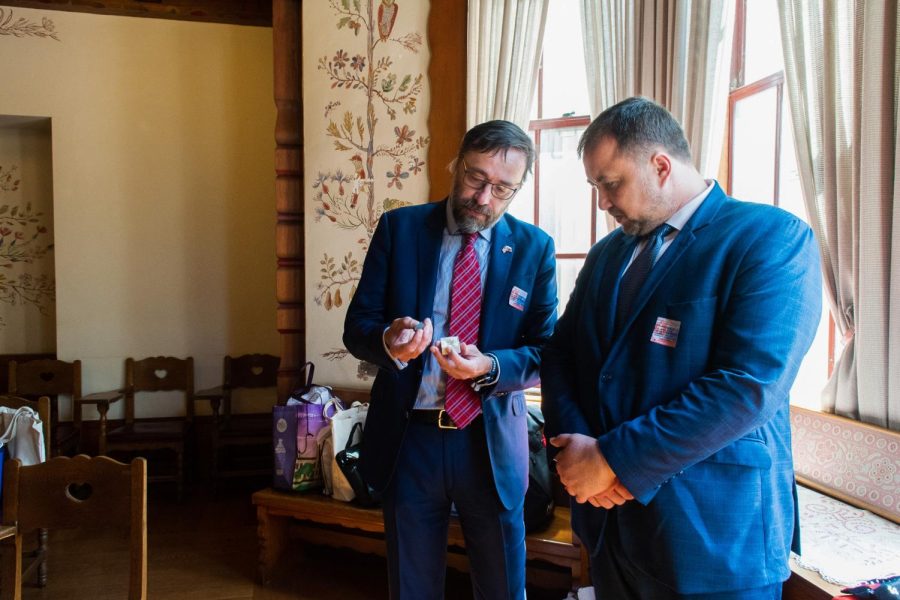‘Truly magnificent’: Slovakian Ambassador to the United States tours Czechoslovak Nationality Room
Pamela Smith | Contributing Editor
Ambassador Radovan Javorcik (left) and Michal Fedák (right) the Slovak Republic’s state secretary in the ministry of education, science, research and sport, talk about a small box of rocks and minerals in the Czechoslovakian nationality room in the Cathedral of Learning on Thursday.
June 7, 2023
When the state secretary for the Ministry of Education in Slovakia, Michal Fedák, stepped into the Czechoslovak Nationality Room, he “felt immediately at home.”
“It has touches of our common heritage,” Fedák said. “It looks like classrooms from old movies or like a village house.”
On June 1, Fedák and Radovan Javorčík, the Slovakian ambassador to the United States, visited Pitt’s campus to tour the Czechoslovak room in the Cathedral of Learning. Javorčík noted that Pitt is the only university in the United States to offer a Slovak studies program.
“Obviously, the Slovak faculty and Slovak program is the core of our presence here and in Pittsburgh,” Javorčík said. “It’s natural because Pittsburgh has so many immigrants [from Slovakia].”
The visit started off in the Czechoslovak room with a presentation and tour of the room from Abby Kraus, a rising junior biological sciences major, Slovak Studies minor and Quo Vadis club member. Due to her Slovak heritage and participation in Quo Vadis, Kraus is “proud” of Pitt’s Slovak program, but she wishes it was taught more.

“I wish there were more universities because it’s such a big culture that a lot of people don’t think about,” Kraus said. “Czech is taught at I think about 16 different schools across the US. Meanwhile, Slovak is only taught at one and that seems a little bit unfair. I would love to see more Slovak programs from across the US as more and more people try to embrace their culture.”
Kraus also explained the importance of the Pittsburgh agreement, which primarily established Czechoslovakia as a sovereign state post World War I before the two countries split. Then, the tour continued with visits to the Polish, Russian and Ukrainian Nationality rooms. Both Kraus and Fedák mentioned the ceiling in the Czechoslovak room.
“This is not my first time [visiting the Czechoslovak room] so the first impression for me were the beams,” Fedák said. “The beams are truly magnificent and the ceiling is great.”
As a biological sciences major, Kraus “appreciates” the ceiling with accurate plants from Slovakia.
“I love our botanically accurate flowers,” Kraus said. “But we’re one of only two nationality rooms with accurate flowers, the other being the Philippines room. Being a plant nerd, I really really enjoy the amount of nature motifs in this room.”

Javorčík said that the most important political issue between the United States and Slovakia is keeping the two countries united and safe from outside threats.
“The most pressing thing is to keep our unity and give people their freedom of choice and pursuit of happiness as the U.S. Constitution has it,” Javorčík said. “These are times when there are many challenges, including the Russian war on Ukraine and a lot of competition in business and in science. The most important thing is to keep our goal of cooperation and collaboration as tight as possible.”
Javorčík could potentially foresee cracks developing due to misinformation, but he hopes the upcoming NATO summit will promote unity.
“If there are cracks, these are inserted from outside and exploited by countries who want us to be not united,” Javorčík said. “These are coming from disinformation and exploiting all the debates in democratic society. At the NATO Summit around the corner I think we will be sending strong messages about unity of purpose, of defense, of growth, of our values and our communities.”
Javorčík highlighted what he believes to be the common thread between Pittsburgh and Slovakia — both of their economies were once centered around steel and manufacturing, promoting unity between the United States and Slovakia.
“There is one strong connection between Slovakia and Pittsburgh, and that is U.S. Steel,” Javorčík said. “The only U.S. Steel steel mill outside of the United States is in Slovakia. Pittsburgh and [Slovakia] both went through very vigorous transitions from coal, steel and fuming chimneys to sunny and bustling universities.”

Javorčík also mentioned the research connection between the University of Pittsburgh, an R1 research university, and Slovakia, an EU Minister of Research.
“We are among the EU ministers for educational research,” Javorčík said. “We are talking a lot about trusted partners and partnerships in research. And especially in this geopolitical situation. It’s very nice, useful and necessary to have the U.S. and EU among each other to look around the world and to help other countries.”
Javorčík hopes to see more collaboration between the University of Pittsburgh and Slovakia.
“We were discussing on the way here how to expand and go beyond to see what we can do with other parts of the University of Pittsburgh,” Javorčík said. “I will be trying as an ambassador to look, to connect the dots.”‘Truly magnificent’: Slovakian Ambassador to the United States tours Czechoslovak Nationality Room








